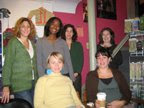You may also have wondered what to do with the tail ends of yarn hanging off the cast-on and bind-off rows. Here's what to do:
(1) When you begin and end your work, and when you add new yarn, make sure that the tails are about 6 inches long. Get yourself a yarn needle (also called a tapestry needle or a blunt needle) and thread the tail through it.
(2) You're going to make that tail invisible by actually following a row of stitches, weaving the yarn into the stitches in the rows above and below. (You're weaving in on the wrong side of the fabric - usually the bumpy purl side.) Have you ever looked closely at the stitch structure? It looks like this:
 Starting from the right, angle your needle so that it goes up through the bottom-row stitch and then up through the upper-row stitch to its right. Next, go down through the next stitch (the upper-row stitch to its left) and down through the bottom-row stitch to the right (the same one you started on). Go up through the bottom-row stitch to its left . . . and so on.
Starting from the right, angle your needle so that it goes up through the bottom-row stitch and then up through the upper-row stitch to its right. Next, go down through the next stitch (the upper-row stitch to its left) and down through the bottom-row stitch to the right (the same one you started on). Go up through the bottom-row stitch to its left . . . and so on.(3)Way to go, knitter! Now you've gained an understanding of stitch structure and made yourself a really professional-looking project. Give yourself a high-five!



4 comments:
But is there a way to weave in ends as I go, without resorting to a tapestry needle?
There is indeed a method to weave in ends as you go, but it won't work for every project. It's simply to hold the tail together with the working yarn and knit them as one. Because this doubles the yarn, it makes your stitches larger, which works fine for a garter stitch scarf, but not so well in a lace panel, or a cardigan front with a very specific gauge. (When you weave in the ends with a tapestry needle, the tail yarn sits behind the working yarn - not next to it - and therefore doesn't affect gauge.) Another disadvantage to this method is that the ends are hidden, which makes it difficult to undo your work, should you need to rip back.
Let us know if you have other questions. Happy knitting!
There is a way, and it's what I do. Here's a good tutorial:
http://sockpr0n.blogspot.com/2006/10/how-to-weave-in-ends-while-knitting.html
You can also do the same thing on the purl side, which isn't shown. You can only do it when working stockinette, or you'll end up with floats on the wrong side. Essentially, purlwise you work it the same way, but with both the working yarn and the end facing you. You wrap the "wrong" yarn (ie, the end) the wrong way around the needle, wrap the "right" yarn (ie, the yarn you are wanting to knit with) the correct way around the needle, unwrap the end over the top of the needle (which is now tacked down to the fabric by the working yarn) and complete the stitch.
Voila!
Thank you for your explanation! I was trying to figure out how to tuck the ends as I went, and found it confusing since I'm purling. Finally got it figured out after reading your detailed explanation. Thanks for taking the time to explain!!
Post a Comment